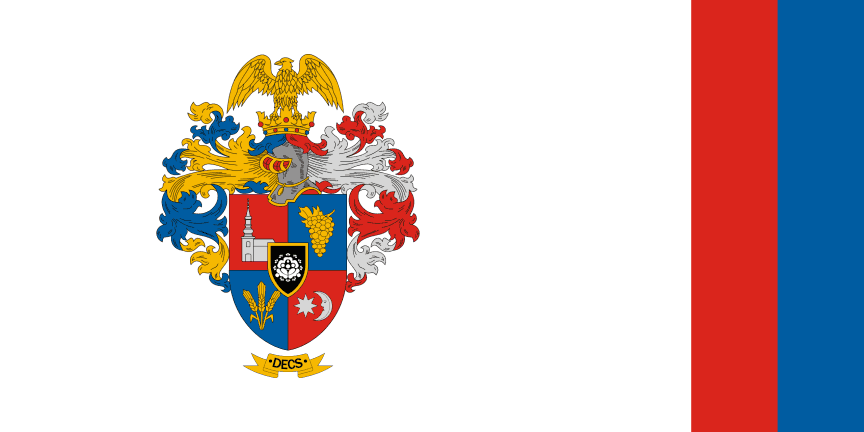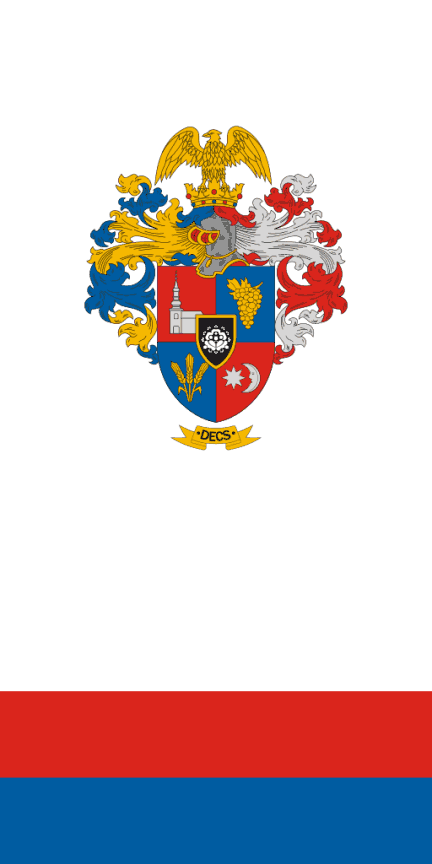 (1:2)
(1:2)image by Zoltan Horvath, 28 January 2025

Last modified: 2025-02-07 by zoltán horváth
Keywords: decs | tolna | hungary |
Links: FOTW homepage |
search |
disclaimer and copyright |
write us |
mirrors
 (1:2)
(1:2)
image by Zoltan Horvath, 28 January 2025
See also:
Decs is a large village in Szekszárd district of Tolna County.
The area of the settlement has been inhabited since the beginning. Bronze Age, Copper Age and Roman finds prove the continuous presence of man in the area.
The name of the village can be derived from the name Gyécsa-Geicsa-Géza, which meant the settling princely tribe.
The oldest written record of the settlement dates back to 1402, in which Pope Boniface IX granted permission to build a stone church.
Only Decs was able to survive the period of Turkish occupation in the relatively densely populated Sárköz, which accepted the doctrines of the Reformation from 1540.
In 1710, due to the plague, the village moved to Eté.
In the years 1769-70, the great floods, then the fire of 1773, tested the population of the settlement.
In 1872, as a result of the protective dam works, the areas of reeds and wild waters were transformed into excellent growing areas, as a result
of which prosperity greeted the settlement, which can also be seen in the buildings. After the World War, a poor, destitute Catholic class flocked to the settlement,
who found a living with the wealthy landowners. During the socialist era, a production cooperative was formed, which was one of the main workplaces until the change of regime.
Since the 1990s, the settlement has been trying to find its identity again, drawing on its roots and sustainably managing its natural and built environmental assets.
Zoltan Horvath, 28 January 2025
The flag of the settlement is white with two vertical stripes at the hoist, red and blue. Width of stripes is one-tenth of length of the flag.
The coat of arms is placed on the white field at one-third from the hoist of the flag. Ratio is 1:2.
The flag was adopted by Local Government Decree 19/1993. (XII.1.) issued on 01 December 1993.
https://or.njt.hu/eli/733326/r/1993/19
Zoltan Horvath, 28 January 2025
 (1:2)
(1:2)
image by Zoltan Horvath, 28 January 2025
The vertical variant has the same elements, but it is rotated 90 degrees upwards.
Zoltan Horvath, 28 January 2025
image by Zoltan Horvath, 28 January 2025
The coat of arms is a shield quartered with red and blue, with a triangular, gold-bordered heart shield in the middle.
The black field of the heart shield shows a floating embroidery motif in white. The first quarter is red with a stylized Reformed church with a baroque tower is depicted in silver.
The second quarter is blue, where a golden grape bunch with leaves is depicted. The third quarter is also blue, where three golden ears of wheat held together on a stem are depicted.
While in the fourth, red quarter, an eight-pointed silver star, and a growing silver crescent moon with a human face is seen.
Above the shield is a helmet, on which a crown is seen, and at the top is a golden Turul bird clinging to a crown.
At the bottom, on a curved gold ribbon, the inscription 'DECS' can be read in black capital letters.
The wheat ear refers to agriculture, which has always been the main livelihood due to the floodplain and fertile lands of the area (the Danube is 10 km away),
and the leafy grape bunch refers to the very old grape and wine culture characteristic of the region.
The coat of arms was adopted by the same Local Government Decree.
Image of coat of arms:
https://decs.hu/ (website of settlement)
Zoltan Horvath, 28 January 2025